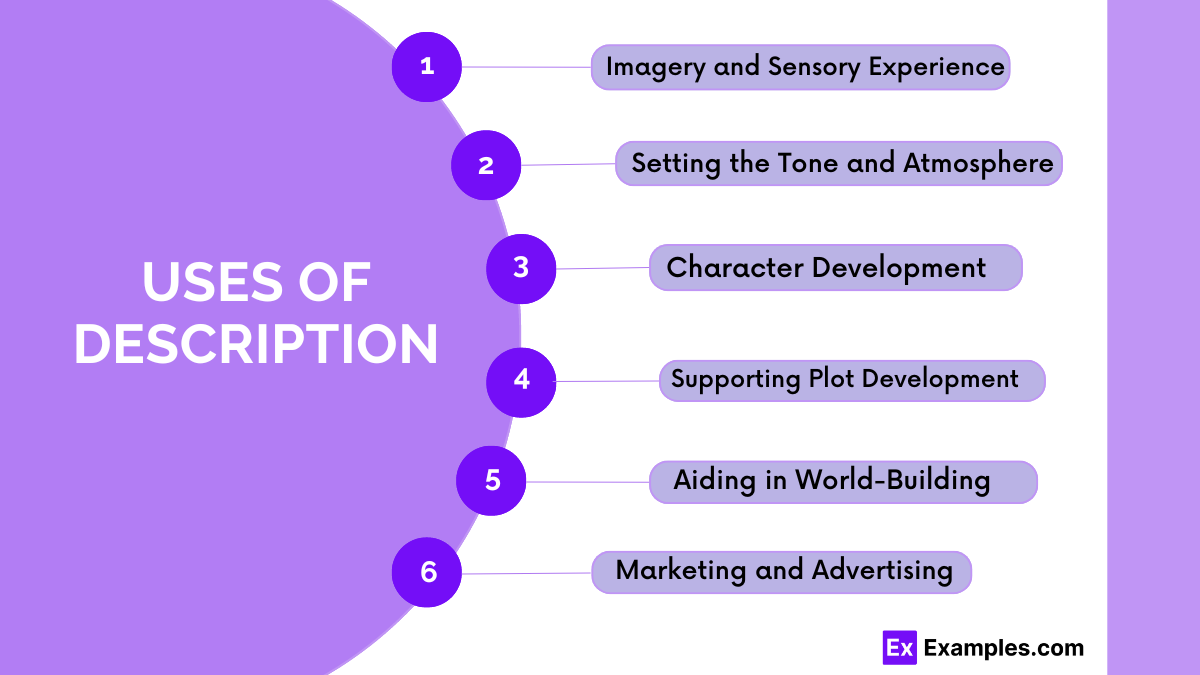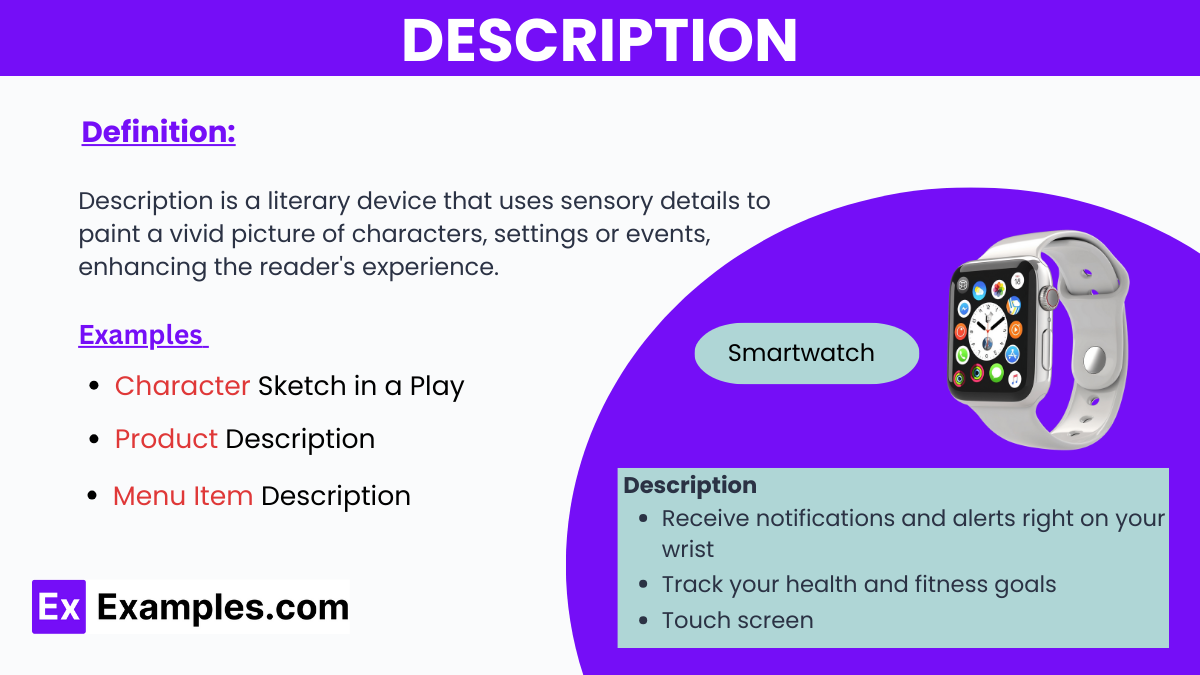10+ Description Examples
Description is the process of depicting or explaining the features or characteristics of something or someone through language, imagery, or other forms of representation. It involves articulating the details, qualities, and attributes that define the subject, whether it be a person, object, event, or concept. Descriptions serve to convey information, evoke sensory experiences, and create vivid mental images in the minds of the audience, allowing them to better understand and visualize the subject being described. Effective descriptions often employ sensory language, metaphor, and vivid detail to engage the reader or listener and bring the subject to life.
What is Description?
Description is a literary device that uses sensory details to paint a vivid picture of characters, settings, or events, enhancing the reader’s experience. By incorporating sights, sounds, smells, and textures, description deepens understanding and emotional connection, setting the mood and contributing to the narrative. Effective description not only enriches the reader’s imagination but also supports plot development and character revelation, making it an essential element in both creative writing and informative content.
Uses of Description

Description serves multiple purposes in both literary and non-literary contexts. Here are some key uses:
1.Enhancing Imagery and Sensory Experience
- Vivid Imagery: Description creates vivid images in the reader’s mind, making the narrative more engaging and memorable by appealing to the senses.
2.Setting the Tone and Atmosphere
- Atmospheric Detail: Detailed descriptions help set the tone and atmosphere of a scene, influencing the reader’s emotional response and overall experience of the text.
3.Character Development
- Revealing Characters: Description can reveal significant details about a character’s personality, emotions, and background through the depiction of their physical appearance, actions, and environments.
4.Supporting Plot Development
- Advancing the Plot: Descriptions of settings and actions can provide necessary background that advances the plot and aids in the development of the story.
5.Aiding in World-Building
- World-Building: In genres like fantasy and science fiction, description plays a crucial role in building a believable world with its own rules, aesthetics, and climates.
6.Informative Purposes
- Educational Clarity: In non-fiction, description helps clarify complex concepts or processes by providing detailed, easy-to-visualize explanations.
7.Marketing and Advertising
- Promotional Impact: In marketing, effective description can enhance the appeal of a product or service, highlighting features and benefits to persuade potential customers.
Short Description Meaning
A short description is a concise explanation or summary that provides essential information about a subject, item, or event without delving into extensive detail. It typically highlights key features or aspects to give the reader or viewer a clear understanding in a brief format. Short descriptions are useful in settings where space is limited, such as product listings, article previews, or database entries, helping to convey the core idea or purpose efficiently.
Description Synonyms
Here are some synonyms for “description” that can be used in various contexts:
- Account
- Explanation
- Narrative
- Portrayal
- Depiction
- Representation
- Elucidation
- Exposition
- Detailing
- Characterization
These synonyms vary slightly in nuance, making them suitable for different uses depending on the specificity and tone desired in the writing.
Description Antonyms
Here are some antonyms for “description,” which represent concepts or terms that are opposite or nearly opposite in meaning:
- Concealment
- Omission
- Silence
- Vagueness
- Generalization
- Confusion
- Misrepresentation
- Distortion
- Ambiguity
- Suppression
These antonyms reflect actions or states that obscure details or avoid providing a clear and detailed portrayal, contrasting with the clarifying and illustrative nature of a description.
Examples of Description
- Novel: “The ancient forest was shrouded in mist; towering trees loomed like silent sentinels, their gnarled branches clawing at the sky. The air, thick with the scent of wet earth and pine, muffled sounds, creating a deep, enveloping silence.”
- Real Estate Listing: “This charming three-bedroom home boasts an updated kitchen with granite countertops and stainless steel appliances, a cozy living room with a wood-burning fireplace, and a spacious backyard with a newly installed patio perfect for summer barbecues.”
- Character Sketch in a Play: “She walked with the majesty of royalty. Her gown flowed behind her like a train of midnight, and her eyes, sharp and commanding, left trails of awe and fear alike.”
- Product Description: “Experience cutting-edge performance with our latest gaming laptop, featuring a 15.6-inch Full HD display, an Intel i9 processor, and NVIDIA GeForce RTX 3080 graphics card. It’s built for speed, designed for durability, and tailored for the ultimate gaming adventure.”
- Travel Brochure: “Step onto the sun-soaked shores of Santorini and gaze upon the crystal blue waters that contrast dramatically with the dazzling white buildings. As the sun sets, the sky turns a soft pink, bathing the island in a magical glow.”
- Menu Item Description: “Indulge in our decadent chocolate lava cake, a rich molten center enveloped in a perfectly baked crust, served with a scoop of vanilla bean ice cream melting slowly beside it.”
- Nature Documentary Script: “As dawn breaks over the Serengeti, the golden sunlight spills across the vast savannah, illuminating herds of wildebeest grazing peacefully. Nearby, a lioness crouches in the tall grass, her gaze fixed intently on her unsuspecting prey.”
- Fashion Catalogue: “Step into style with our sleek, midnight blue velvet blazer, featuring a slim fit that elegantly contours your silhouette. The subtle shimmer of the fabric catches the light with every movement, exuding sophistication and charm.”
- Historical Biography: “He stood over six feet tall, with a bearing that commanded attention whenever he entered the room. His deep-set eyes, always alert, missed nothing, reflecting a mind as sharp and expansive as the great library of Alexandria.”
- Art Exhibition Guide: “This striking painting captures a tumultuous sea under a tempestuous sky, where dark, swirling clouds meet frothing waves in a dance of chaotic beauty. Each brushstroke conveys the raw power and relentless motion of nature’s fury.”
- Tech Product Review: “The latest smartphone from XYZ brand is a marvel of modern technology, encased in a sleek, durable glass body that’s both water-resistant and dustproof. Its crystal-clear, edge-to-edge display makes watching videos and browsing the web a visually stunning experience.”
Examples of Description in a Sentence
- Morning Scene: “The early morning sun cast a golden glow over the dew-speckled meadow, transforming it into a shimmering canvas of light and shadow.”
- Character Portrait: “Her eyes, a piercing shade of emerald, seemed to hold secrets as old as the ancient forest that bordered the town.”
- Urban Landscape: “The city skyline was a jagged line of silhouettes against the fading pink of dusk, with lights flickering to life in the sprawling metropolis below.”
- Seasonal Change: “Autumn arrived, cloaking the park in vibrant hues of scarlet and gold, with leaves crunching underfoot like a symphony of whispers.”
- Gastronomic Delight: “The freshly baked bread wafted a warm, yeasty aroma that filled the kitchen, promising comfort in every butter-slathered slice.”
- Emotional Atmosphere: “A tense silence fell over the room, thick and suffocating, as if the air itself was holding its breath.”
- Historical Setting: “The ancient castle walls, weathered and worn by centuries of battles, stood defiantly against the howling wind that swept through the barren landscape.”
- Mystical Element: “Under the full moon, the lake glimmered like a mirror, reflecting a world upside down, with stars twinkling both above and below.”
- Animal Behavior: “The cat moved with the stealth of a shadow, its soft paws silent on the hardwood floor as it stalked the unsuspecting toy mouse.”
- Technological Innovation: “The drone hovered noiselessly above the crowd, its cameras scanning the scene below, capturing moments in high-definition clarity.”
FAQ’s
What is the difference between discription and description?
The word “discription” is a common misspelling of “description.” “Description” refers to the act of depicting or detailing characteristics or features of something in words.
How do you write a good description?
To write a good description, focus on sensory details, use vivid language, incorporate adjectives and adverbs thoughtfully, and aim to evoke the reader’s emotions or senses.
What are the types of description?
Descriptions can be objective, focusing on factual and neutral details, or subjective, incorporating personal feelings and perceptions. They can also be physical, describing appearances, or psychological, describing emotions and thoughts.
How does description differ from narration?
Description focuses on detailing qualities and characteristics of something, while narration tells a story or recounts events. Description enriches the narrative by providing detailed imagery and context.



